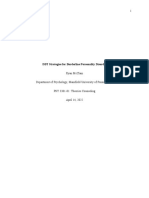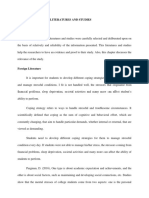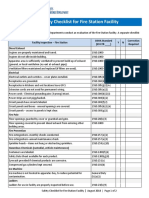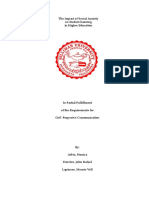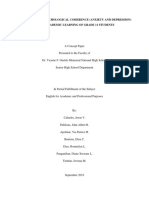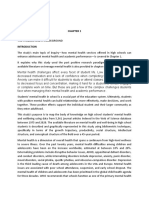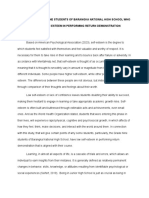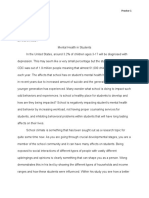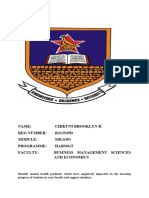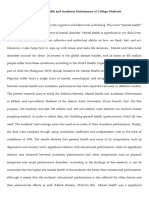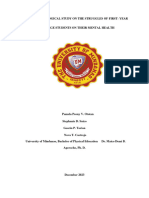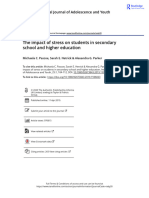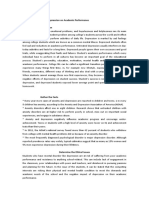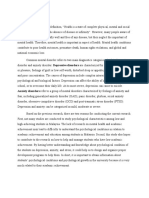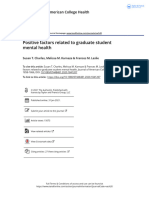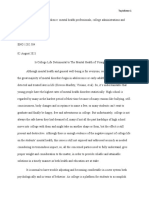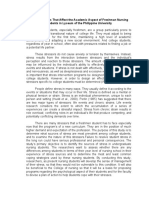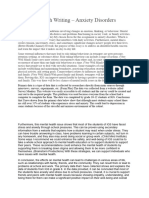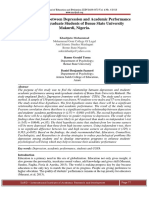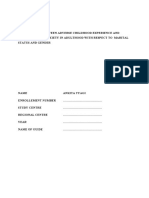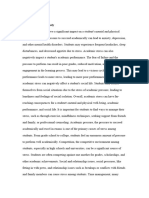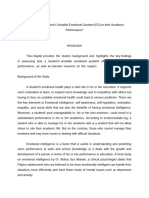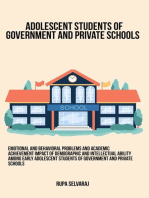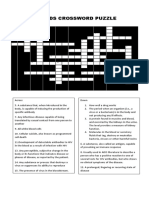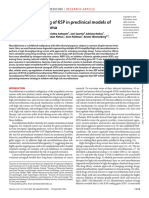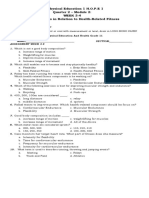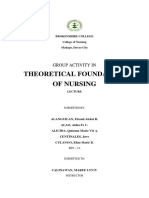0 ratings0% found this document useful (0 votes)
5 viewsChapter Ii
Chapter Ii
Uploaded by
janahkrishafaithbernardoCopyright:
© All Rights Reserved
Available Formats
Download as DOCX, PDF, TXT or read online from Scribd
Chapter Ii
Chapter Ii
Uploaded by
janahkrishafaithbernardo0 ratings0% found this document useful (0 votes)
5 views3 pagesOriginal Title
CHAPTER II
Copyright
© © All Rights Reserved
Available Formats
DOCX, PDF, TXT or read online from Scribd
Share this document
Did you find this document useful?
Is this content inappropriate?
Copyright:
© All Rights Reserved
Available Formats
Download as DOCX, PDF, TXT or read online from Scribd
Download as docx, pdf, or txt
0 ratings0% found this document useful (0 votes)
5 views3 pagesChapter Ii
Chapter Ii
Uploaded by
janahkrishafaithbernardoCopyright:
© All Rights Reserved
Available Formats
Download as DOCX, PDF, TXT or read online from Scribd
Download as docx, pdf, or txt
You are on page 1of 3
CHAPTER II
REVIEW OF RELATED LITERATURE
Academic Performance as an Outcome Academic performance becomes relevant at a young age. In grade
school, children are given report cards to inform their caretakers on how they are doing. In middle school,
academic performance determines whether you are in remedial, regular, or advanced courses. In high
school, students that perform well academically can take advanced placement (AP) classes which can lead
to college credit, depending on AP test scores. At the high school level, grade point average (GPA) and
class ranking carry more weight as they are relied on by college admissions staff. Students study for and
take Scholastic Aptitude Tests (SAT) and hope to get higher scores to increase their chances of getting
accepted to the colleges that they apply to. The pressure increases to perform well academically as a
student journey through the education system, and after high school this pattern continues. College
students are under immense pressure internally and externally to succeed. Higher educational settings
reinforce the message that performing well academically is critical to being successful. Many universities
invest resources to assist students to succeed, such as tutoring, supplemental instruction, or other support
services, such as SOAR. SOAR provides support and connects students to available resources. Some
students perform better than others in this environment depending on a multitude of factors. Intellectual
aptitude, cognitive ability, physical health, and mental health are just some of the factors that affect 5
students’ ability to be successful in college. Factors such as past academic performance as well as
standardized testing influence academic performance. Standardized test scores and GPA are frequently
used to measure intellectual aptitude. There is much debate as to how effectively grades measure
academic performance. One of the arguments for this is the subjective nature of grades. Grades given by
different professors can vary significantly for the same level of work. Some may even say that this
undermines a GPA as a reliable measurement of academic achievement. It may be useful to have some
brief background on how grades arose in the educational setting. There are several constituencies of
higher education that are interested in a way to assess institutions and students. These constituencies
include, but are not limited to, governmental agencies (such as the Department of Education), non-profit
organizations (foundations), and corporations. This can be to assess funding of the colleges and
universities, as well as distributing financial aid. There are many merit-based grants and scholarships that
allocate these funds to students using their GPA as a measurement. In addition, a GPA provides graduate
programs with a tangible way to evaluate applicants and organizations with information that may be used
in the hiring process. It is often a flawed system, but grading as a measurement has been used by some
colleges as early as the 1860s. GPA is influenced by a variety of factors such as cognitive ability, physical
health, and mental health. Intellectual aptitude and other cognitive factors can have an influence on how
students perform academically in a higher educational setting. Only approximately twenty-five percent of
variance in academic performance is attributed to cognitive factors. The rest of variance in academic
performance can be attributed to factors related to physical and mental health. To understand mental
health of college students, it is important to be aware of the developmental challenges and strengths that
this demographic faces. A study done by Larson, Orr, and Warne (2016) explored both physical and
mental health issues. Some of the physical health difficulties the study measured included asthma,
allergies, mononucleosis, strep throat, and urinary tract infections. The study found that mental health
issues were significantly and negatively associated with GPA. The results of the study also showed that
physical health issues were often correlated with mental health issues. For example, students who had
high levels of stress, or difficulties handling stress, reported physical health issues affecting their diet and
sleep. In working with students with anxiety and depression, the physical health symptoms are often 7
reported as the presenting problem because they are the symptoms that are externalized. Erikson’s (1966)
theory of psychosocial development is made up of eight stages in which an individual is confronted with
various challenges. Because most individuals entering college are young adults, many of them are in the
fifth and sixth stages of psychosocial development. The fifth stage is labeled identity vs. role confusion
and the sixth stage of psychosocial development is labeled intimacy vs. isolation. This means that college
students are trying to figure out their identity as well as learning to interact and connect with others.
Social interactions and experiences can also affect and reshape identity by shifting values, attitudes, and
goals. Many individuals go to college or a university to pursue the career they would like, and for many, it
is the logical next step. Students in college or attending a university face several challenges. Increased
academic expectations, meeting new people, being away from family for the first time, living on their
own, increased exposure to alcohol and drugs, are some of the trials that this population experience.
(Mitchell, MacInnes, & Morrison, 2008). Many college students can get through this transition
successfully, but others have difficulty adjusting academically and/or psychosocially (Brook &
Willoughby, 2015). Because of these challenges, college students are a population that are at a high risk
for mental health issues (Khubchandani, Brey, Kotecki, Kleinfelder, & Anderson, 2015). Depression and
anxiety are found to be the most common mental health issues that are reported by this population.
Difficulties with mental health symptoms can become 8 serious and even fatal if they go untreated. In a
study done by Drum, Bronson, Denmark & Smith (2009), it was found that eighty percent of college
students that committed suicides had no current or prior counseling. These results were found after
surveying university and college counseling center directors and indicated that many students with mental
health issues suffer silently and do not seek or receive treatment. Psychological distress, including
depression and anxiety, has been associated with lower GPAs. It is also important to note that sometimes
academic pressures as well as adjusting to college can contribute to psychological disorders (Tanaka &
Huba, 1987). Anxiety and Academic Performance The word anxiety is derived from Latin word
“angere,” meaning to cause distress (Sharma & Sharma, 2015). Anxiety has also been defined as a vague,
uncomfortable feeling exacerbated by prolonged stress and the presence of multiple stressors (Lazarus &
Folkman, 1984). Per the DSM V, generalized anxiety is “anticipation of future threat” and is often
associated with “vigilance in preparation for future danger and cautious or avoidant behaviors” (American
Psychiatric Association, 2013, p. 189). A study recently done by the Anxiety and Depression Association
revealed that seven out of ten adults in the General Santos City experience a moderate level of anxiety or
stress daily (as cited in Beiter et al. 2014). Normative anxiety may include being concerned about issues
such as money, health, and/or family problems, but those with an anxiety disorder are extremely worried
about these or other things, even when there is little or no reason to worry about them. They are very
anxious about getting through the day, have a 9 negative outlook, and think that things will go wrong.
Anxiety disorders feature excessive fear or anxiety that persist beyond developmentally appropriate
lengths of time. These disorders cause clinically significant impairment or distress in important areas of
functioning. The different types of anxiety disorders are categorized by the type of objects or situations
that cause the anxiety and can have different ages of onset. One type of anxiety is social anxiety, which is
marked by fear or anxiety of social situations in which individuals feel that he/she will be scrutinized by
others. Social anxiety has been found as a barrier to developing social ties in several studies. This type of
anxiety is found to be more prevalent in college students, ranging from ten to thirty-three percent, when
compared to the general population, ranging from seven to thirteen percent. To meet criteria for an
anxiety disorder diagnosis, the individual must experience the excessive anxiety and worry that he/she
finds difficult to control for at least six months to the extent which it causes significant distress or
impairment in functioning. The individual must also experience three or more of these symptoms: sleep
disturbances, difficulty concentrating, restlessness, fatigue, irritability, and muscle tension. Many children
develop an anxiety disorder when they are young and often go untreated, causing the symptoms and
negative effects to persist and manifest in various forms (American Psychiatric Association, 2013).
Anxiety can also start during the teen years or young adulthood as peer interaction becomes increasingly
important (National 10 Institute of Mental Health, 2013). Symptoms may get better or worse at different
times, and often are worse during times of stress. Young adults often use maladaptive coping skills such
as safety or avoidant behaviors, risk-taking behaviors, alcohol and/or drug abuse to try to manage their
anxiety alone. Many of these will reduce the symptoms in the short-term, while continuing to strengthen
and maintain the disorder in the long term.
You might also like
- The Encyclopaedia of Medical Astrology by Dr. Howard Leslie CornellDocument5 pagesThe Encyclopaedia of Medical Astrology by Dr. Howard Leslie CornellANTHONY WRITER38% (8)
- DBT For Borderline Personality DisorderDocument17 pagesDBT For Borderline Personality Disorderapi-595939801No ratings yet
- Review Journal Articles FinalDocument6 pagesReview Journal Articles FinalLeo PilayanNo ratings yet
- Review of Related Literatures and Studies LLLLDocument17 pagesReview of Related Literatures and Studies LLLLreynald salva95% (19)
- Fire Departments - Safety Checklist For Fire Station Facility (Final)Document2 pagesFire Departments - Safety Checklist For Fire Station Facility (Final)DAVE HOWARDNo ratings yet
- Krishnamacharya's 32 SirsasanaDocument34 pagesKrishnamacharya's 32 SirsasanaAnthonyNo ratings yet
- Social Anxiety ResearchDocument21 pagesSocial Anxiety ResearchJohn DoroteoNo ratings yet
- The Effects of Psychological Coherence (Anxiety and Depression) in The Academic Learning of Grade 11 StudentsDocument11 pagesThe Effects of Psychological Coherence (Anxiety and Depression) in The Academic Learning of Grade 11 StudentsSean Andre PillosNo ratings yet
- Chap 2Document5 pagesChap 2velascofaithricarose17No ratings yet
- Chapter-123 Group 6Document63 pagesChapter-123 Group 6louie diamosNo ratings yet
- A Phemenological Study On The Mental Health Condition of Senior High School Students in Quinaoayanan National High School S.Y 2022 - 2023Document10 pagesA Phemenological Study On The Mental Health Condition of Senior High School Students in Quinaoayanan National High School S.Y 2022 - 2023Richell Ann OrioqueNo ratings yet
- Final Globalissuesreport AlvarezDocument14 pagesFinal Globalissuesreport Alvarezapi-459383663No ratings yet
- Ups and Down Academic Stress and Coping Strategies Among Cas Student 5Document23 pagesUps and Down Academic Stress and Coping Strategies Among Cas Student 5Pot ChieNo ratings yet
- LOUIE-DIAMOS Docx123Document63 pagesLOUIE-DIAMOS Docx123louie diamosNo ratings yet
- FlourishDocument17 pagesFlourishnkrauchankaNo ratings yet
- Number of Grade Nine Students of Barangka National High School Who Have Low Self-Esteem in Performing Return DemonstrationDocument6 pagesNumber of Grade Nine Students of Barangka National High School Who Have Low Self-Esteem in Performing Return DemonstrationKim Erish CabaliNo ratings yet
- Literature Review: Students and Anxiety Piña 1Document6 pagesLiterature Review: Students and Anxiety Piña 1api-534522249No ratings yet
- Mental Health in StudentsDocument12 pagesMental Health in Studentsapi-548796244No ratings yet
- Chapter 1: The Problem and Its Background IntroductionDocument17 pagesChapter 1: The Problem and Its Background IntroductionChristian VillaNo ratings yet
- Sdlsbe Assignment Harmgt r213545dDocument5 pagesSdlsbe Assignment Harmgt r213545dBrooklyn ChikuniNo ratings yet
- Final Essay Ap ResearchDocument24 pagesFinal Essay Ap Researchapi-550971943No ratings yet
- Assesment Assignment FinalDocument13 pagesAssesment Assignment FinalKaleb MayesNo ratings yet
- Chapter 123Document63 pagesChapter 123louie diamosNo ratings yet
- Stress and Mental Health of Undergradute Students at A Private Higher Learning Institution in MalaysiaDocument13 pagesStress and Mental Health of Undergradute Students at A Private Higher Learning Institution in MalaysiaGlobal Research and Development Services0% (1)
- The Relationship of Mental Health and Academic Performance of College StudentsDocument5 pagesThe Relationship of Mental Health and Academic Performance of College StudentsLpc Geremy Impas OwelNo ratings yet
- The Impact of Stress On Students in Secondary School and Higher EducationDocument10 pagesThe Impact of Stress On Students in Secondary School and Higher EducationliaNo ratings yet
- Final Research2Document9 pagesFinal Research2NOVA CASTROJONo ratings yet
- Chapter 1Document6 pagesChapter 1Ofelia PedelinoNo ratings yet
- Stress Is A Common Experience For Many Students in SchoolDocument4 pagesStress Is A Common Experience For Many Students in Schoollexter Marcia2ndNo ratings yet
- Research About Self-ConfidenceDocument4 pagesResearch About Self-ConfidenceRyuko27No ratings yet
- The Impact of Stress On Students in Secondary School and Higher EducationDocument10 pagesThe Impact of Stress On Students in Secondary School and Higher EducationmenesesjelloNo ratings yet
- Research Paper Psych 1Document6 pagesResearch Paper Psych 1api-656782995No ratings yet
- Academic Stress, Anxiety and Depression Among College StudentsDocument9 pagesAcademic Stress, Anxiety and Depression Among College StudentsSamar HamadyNo ratings yet
- Document 5Document3 pagesDocument 5Trisha Mae HernandezNo ratings yet
- Depressive Disorders Are Characterized by Sadness, Loss of InterestDocument3 pagesDepressive Disorders Are Characterized by Sadness, Loss of InterestSyafiq FauziNo ratings yet
- Education EssayDocument13 pagesEducation Essayapi-669204574No ratings yet
- The Impact of Stress On Students in Secondary SchoDocument9 pagesThe Impact of Stress On Students in Secondary SchoJohn markNo ratings yet
- Positive Factors Related To Graduate Student Mental Health: Journal of American College HealthDocument10 pagesPositive Factors Related To Graduate Student Mental Health: Journal of American College HealthjuliahahngarciaNo ratings yet
- Final IntroDocument4 pagesFinal IntroTaò KòNo ratings yet
- The Impact of Depression On Academic Success and Academic Help Seeking AttitudesDocument16 pagesThe Impact of Depression On Academic Success and Academic Help Seeking AttitudesAnonymousNo ratings yet
- Research EssayDocument11 pagesResearch Essayapi-559238330No ratings yet
- Major Stressors That Affect The Academic Aspect of Freshman Nursing Students in Lyceum of The Philippine UniversityDocument25 pagesMajor Stressors That Affect The Academic Aspect of Freshman Nursing Students in Lyceum of The Philippine UniversityelaineilaganNo ratings yet
- Final Intergrated SummaryDocument65 pagesFinal Intergrated Summaryapi-284886349No ratings yet
- UntitledDocument10 pagesUntitledDorothea LaroyaNo ratings yet
- Group 2 Chapter 1 CorrectDocument12 pagesGroup 2 Chapter 1 CorrectMoyegun OluwasegunNo ratings yet
- Influence of Self-Esteem On In-School Adolescent Resilience To Peer Pressure Among Senior Secondary School Students in Osogbo, Osun State, NigeriaDocument9 pagesInfluence of Self-Esteem On In-School Adolescent Resilience To Peer Pressure Among Senior Secondary School Students in Osogbo, Osun State, NigeriaAmalin sufiaNo ratings yet
- Research PaperDocument10 pagesResearch Paper2rhxmppdnzNo ratings yet
- Mental HealthDocument3 pagesMental Healthlkimigs24No ratings yet
- The Relationship Between PDFDocument9 pagesThe Relationship Between PDFezatul najwaNo ratings yet
- Synopsis - NEW Project Psychology NEW (F)Document21 pagesSynopsis - NEW Project Psychology NEW (F)Ankita TyagiNo ratings yet
- Argumentative Essay On Mental Health and Academic Performance of College StudentsDocument9 pagesArgumentative Essay On Mental Health and Academic Performance of College StudentsfatehbirsinghbrarNo ratings yet
- Review of Related LiteratureDocument19 pagesReview of Related LiteratureAngelo LakimNo ratings yet
- Different Sources of Stress Among Grade 11 Stem Students of San Juan de Dios Educational Foundation Inc. - College On First Semester Academic Year 2018 - 2019Document7 pagesDifferent Sources of Stress Among Grade 11 Stem Students of San Juan de Dios Educational Foundation Inc. - College On First Semester Academic Year 2018 - 2019Janne KyutNo ratings yet
- Chapter 1Document4 pagesChapter 1Aira jaya D BayunganNo ratings yet
- Impact of Pandemic To The Psychological Aspects of Nursing StudentsDocument25 pagesImpact of Pandemic To The Psychological Aspects of Nursing StudentsBrandon AreteNo ratings yet
- DocumentDocument4 pagesDocumentJamaica SaladagaNo ratings yet
- Chap 1 EnglishDocument9 pagesChap 1 Englishyasminva2017No ratings yet
- Discovering The Lived Experiences of Students Parental Pressure Group 1Document10 pagesDiscovering The Lived Experiences of Students Parental Pressure Group 1geronlupase69No ratings yet
- Chapter IIDocument10 pagesChapter IIAdam Catane PalenNo ratings yet
- NIH Public Access: Adolescents With Depressive Symptoms and Their Challenges With Learning in SchoolDocument19 pagesNIH Public Access: Adolescents With Depressive Symptoms and Their Challenges With Learning in SchoolSusi RutmalemNo ratings yet
- GT Student Mental Health ReportDocument15 pagesGT Student Mental Health Reportapi-445906555No ratings yet
- (Stress and College Student in Taiwan)Document8 pages(Stress and College Student in Taiwan)jhunedaeNo ratings yet
- Self-Regulation Skills How To Control And Regulate The Learning ProcessFrom EverandSelf-Regulation Skills How To Control And Regulate The Learning ProcessNo ratings yet
- Emotional and behavioral problems and academic achievement impact of demographic and intellectual ability among early adolescent students of government and private schoolsFrom EverandEmotional and behavioral problems and academic achievement impact of demographic and intellectual ability among early adolescent students of government and private schoolsNo ratings yet
- SG Recency Primacy WordsDocument1 pageSG Recency Primacy WordsBala Subramanian R RCBSNo ratings yet
- 038-80magnetdiag Rehabilitation English 602 PDFDocument95 pages038-80magnetdiag Rehabilitation English 602 PDFMihaellaBoncătăNo ratings yet
- Neonatal Resuscitation Current IssuesDocument11 pagesNeonatal Resuscitation Current Issuesjimmy tNo ratings yet
- Offshore Wind Electrical Safety Standards Harmonization: Workshop ProceedingsDocument145 pagesOffshore Wind Electrical Safety Standards Harmonization: Workshop Proceedingsbondsivamani100% (1)
- FCE Listening Practice Test 13 PrintableDocument4 pagesFCE Listening Practice Test 13 PrintableEdgar SchultzNo ratings yet
- Pros and Cons of Abortion To The Society Argumentative EssayDocument10 pagesPros and Cons of Abortion To The Society Argumentative EssayimnasNo ratings yet
- FastBraiin Focus Planner DigitalDocument13 pagesFastBraiin Focus Planner DigitalKhrys Hardy100% (5)
- H.I.V. Crossword PuzzleDocument3 pagesH.I.V. Crossword Puzzlejackie pascualNo ratings yet
- IIT HYD PH - DAdmissionBrochureDec2022-2-2Document3 pagesIIT HYD PH - DAdmissionBrochureDec2022-2-2svirajitham readNo ratings yet
- Therapeutic Targeting of KSP in Preclinical Models of High-Risk NeuroblastomaDocument16 pagesTherapeutic Targeting of KSP in Preclinical Models of High-Risk Neuroblastomaka1400ra-sNo ratings yet
- Happiness: Junita Elfrida Capah 20217470085Document14 pagesHappiness: Junita Elfrida Capah 20217470085JunitaNo ratings yet
- Surgical Scrubbing Gowning and Gloving OSCE GuideDocument16 pagesSurgical Scrubbing Gowning and Gloving OSCE GuideBasmah 7No ratings yet
- Seajet 021 EkoDocument2 pagesSeajet 021 EkoAleš NovakNo ratings yet
- Physical Education 1 H.O.P.E 1 Quarter 2 - Module 2: WEEK 3-4 Athletics in Relation To Health-Related FitnessDocument1 pagePhysical Education 1 H.O.P.E 1 Quarter 2 - Module 2: WEEK 3-4 Athletics in Relation To Health-Related FitnessSharon May JavierNo ratings yet
- Ethical Practice in Telehealth and TelemedicineDocument5 pagesEthical Practice in Telehealth and TelemedicineThaysa LimaNo ratings yet
- Penders Health Promotion ModelDocument7 pagesPenders Health Promotion ModelANIME SOLONo ratings yet
- CANTILEVER DENTAL BRIDGE حيدر حسين عليويDocument1 pageCANTILEVER DENTAL BRIDGE حيدر حسين عليويHayder HussienNo ratings yet
- Qru3063 A211 Group: 3 Project Title: Rilia Thinking Template For PBL Activities Relevant Information Learning Issues Inquiry ActivitiesDocument2 pagesQru3063 A211 Group: 3 Project Title: Rilia Thinking Template For PBL Activities Relevant Information Learning Issues Inquiry ActivitiesIzzati AzmiNo ratings yet
- Class Room Teaching ON Training/ Supervision/ Collaboration With Other Functionaries in CommunityDocument2 pagesClass Room Teaching ON Training/ Supervision/ Collaboration With Other Functionaries in CommunityVarna MohanNo ratings yet
- Khyree HamelDocument4 pagesKhyree Hamelapi-547776760No ratings yet
- Pakistan Medical Commission Ord 2019Document32 pagesPakistan Medical Commission Ord 2019Naveed AkhterNo ratings yet
- Application of Facilitatory Approaches in Developmental DysarthriaDocument22 pagesApplication of Facilitatory Approaches in Developmental Dysarthriakeihoina keihoinaNo ratings yet
- A. Define Infertility: Objectives: Intended Learning Outcomes That TheDocument2 pagesA. Define Infertility: Objectives: Intended Learning Outcomes That TheJc Mae CuadrilleroNo ratings yet
- Rushere Community Hospital AdvertDocument3 pagesRushere Community Hospital AdvertZirimenya JoelNo ratings yet
- Resume Jurnal-Dessy Dwi H 201720401011160Document3 pagesResume Jurnal-Dessy Dwi H 201720401011160Pratiwi UmbohNo ratings yet
- 01.27.21 BNC MinutesDocument3 pages01.27.21 BNC Minutescambaro multipurposehallNo ratings yet

